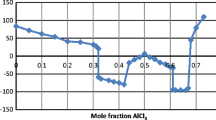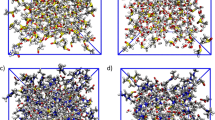Abstract
Solvophobic effects strongly influence the thermodynamic properties of solutions and are one of the driving forces of self-assembly processes of supramolecular structures. However, the generally accepted definition and a quantitative measure of these effects have so far been absent. Based on the analysis of a large set of experimental data on the thermodynamic functions of solvation in various systems, we propose a qualitative criterion allowing us to judge about whether the solvophobic effects are manifested in the solution or not, and also a method to determine their contributions to the thermodynamic functions of solvation. A feature of the solvophobic effect is a violation of the linear relationship between the Gibbs free energy and the enthalpy of solvation, which is fulfilled for the solutions of different compounds in many non-associated solvents. It is shown that in self-associated solvents the solvophobic effect is observed for any dissolved compounds, including well soluble ones, resulting in an increase in the Gibbs energy of solvation. Previously proposed solvophobicity parameters are considered and compared with our results.
Similar content being viewed by others
References
W. Blokzijl and J. B. F. N. Engberts, Angewandte Chemie International Edition in English, 32, No. 11, 1545–1579 (1993).
Yu. M. Kessler and A. L. Zaitsev, Solvophobic Effects [in Russian], Khimiya, Leningrad (1989).
A. Ray, Nature, 231, No. 5301, 313–315 (1971).
T. L. Greaves and C. J. Drummond, Chem. Soc. Rev., 42, No. 3, 1096–1120 (2013).
S. López-Grío, J. J. Baeza-Baeza, and M. C. García-Alvarez-Coque, Chromatographia, 48, Nos. 9/10, 655–663 (1998).
M. N. Rodnikova, Rus. J. Phys. Chem., 80, No. 10, 1605–1607 (2006).
I. Bakó et al., J. Chem. Phys., 132, No. 1 (2010).
O. Sinanoglu, in: Solvent Effects on Molecular Associations, B. Pullman (ed), Academic Press, New York (1968), p. 427.
C. Horváth, W. Melander, and I. Molnár, J. Chromatography A, 125, No. 1, 129–156 (1976).
M. H. Abraham, P. L. Grellier, and R. A. McGill, J. Chem. Soc., Perkin Trans. 2, No. 3, 339 (1988).
D. F. Evans, Langmuir, 4, No. 1, 3–12 (1988).
M. L. Moyá et al., J. Colloid Interface Sci., 316, No. 2, 787–795 (2007).
P. W. Carr et al., J. Chromatography A, 656, Nos. 1/2, 113–133 (1993).
J. Sangster, Octanol-Water Partition Coefficients: Fundamentals and Physical Chemistry, Wiley, Chichester-New York (1997).
P. L. Huyskens et al., J. Phys. Chem., 92, No. 23, 6841–6847 (1988).
P. Ruelle, Chemosphere, 40, No. 5, 457–512 (2000).
I. A. Sedov, M. A. Stolov, and B. N. Solomonov, J. Phys. Org. Chem., 24, No. 11, 1088–1094 (2011).
L. Liu and Q.-X. Guo, Chem. Rev., 101, No. 3, 673–696 (2001).
A. R. Katritzky et al., J. Chem. Inform. Model., 45, No. 4, 913–923 (2005).
J. Li et al., Theoret. Chem. Acc.: Theory, Comput. Model. (Theoretica Chimica Acta), 103, No. 1, 9–63 (1999).
I. A. Sedov and B. N. Solomonov, J. Chem. Thermodyn., 64, 120–125 (2013).
I. A. Sedov and B. N. Solomonov, J. Phys. Org. Chem., 25, No. 12, 1144–1152 (2012).
I. A. Sedov and B. N. Solomonov, J. Chem. Engin. Data, 56, No. 4, 1438–1442 (2011).
I. A. Sedov and B. N. Solomonov, Rus. J. Phys. Chem. A, 82, No. 5, 704–708 (2008).
I. A. Sedov and B. N. Solomonov, J. Chem. Thermodyn., 42, No. 9, 1126–1130 (2010).
Author information
Authors and Affiliations
Corresponding author
Additional information
Original Russian Text © 2013 I. A. Sedov, B. N. Solomonov.
__________
Translated from Zhurnal Strukturnoi Khimii, Vol. 54, Supplement 2, pp. S267–S275, 2013.
Rights and permissions
About this article
Cite this article
Sedov, I.A., Solomonov, B.N. Solvophobic effects: Qualitative determination and quantitative description. J Struct Chem 54 (Suppl 2), 262–270 (2013). https://doi.org/10.1134/S0022476613080076
Received:
Published:
Issue Date:
DOI: https://doi.org/10.1134/S0022476613080076




